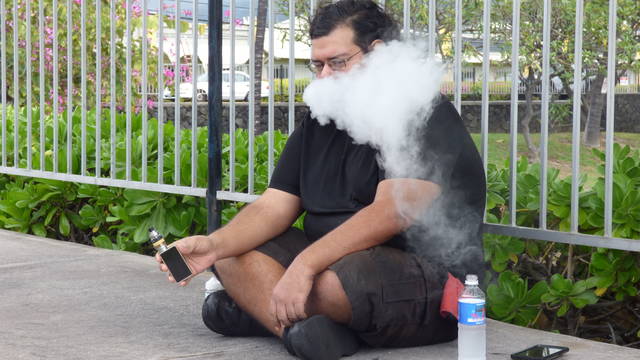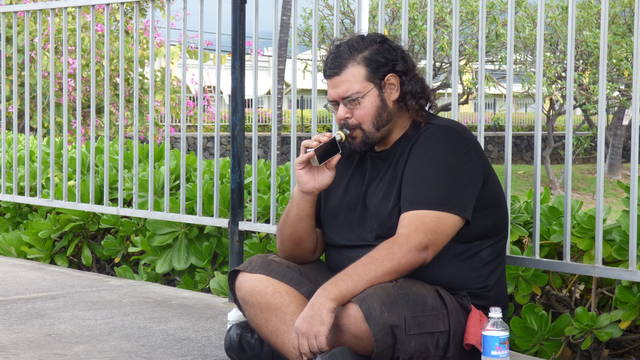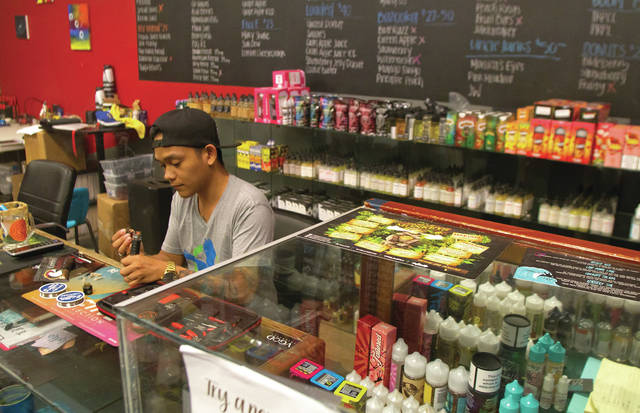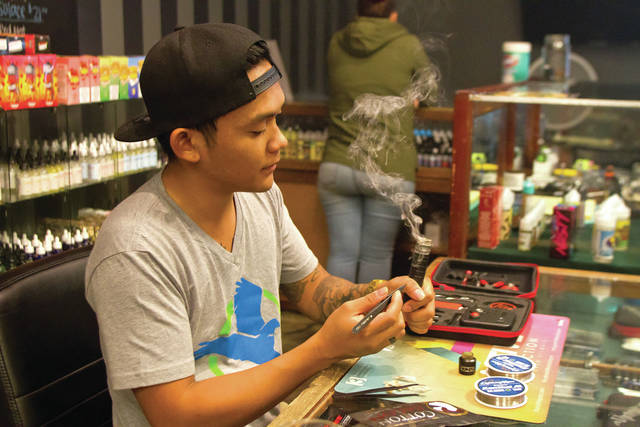Something in the air: Understanding vaping

Robert Anthony, 33, has been vaping for two years and said it helped him quit smoking cigarettes. (Tom Hasslinger/West Hawaii Today)


Billy Gebin works on a customer’s “mod” at the Black Lava Vape shop in Kailua-Kona on Tuesday. (Rick Winters/West Hawaii Today)

Billy Gebin works on a customer’s “mod” at the Black Lava Vape shop in Kailua-Kona on Tuesday. (Rick Winters/West Hawaii Today)
KAILUA-KONA — Clouds are as common a sight in Waimea as they are almost anywhere on Hawaii Island. But a particular and ever-more-present sort of plume billowing throughout the region has created some concern among residents there.
KAILUA-KONA — Clouds are as common a sight in Waimea as they are almost anywhere on Hawaii Island. But a particular and ever-more-present sort of plume billowing throughout the region has created some concern among residents there.
Vaping, and the questions surrounding this sometimes scarcely understood smoking alternative, prompted a Waimea Community Association meeting March 1 to peer through the haze surrounding the controversial practice.
The presence of Black Lava Vape, which has operated a location in Kailua-Kona since June of 2013 and opened a second space in Waimea in October, has intensified the discussion.
“There is some community concern and that was really kind of what prompted us to have the meeting — because I was getting so many calls,” said Patti Cook, president of the WCA.
The meeting featured a question-and-answer session with multiple panelists, including a health professional, an educator, an anti-smoking advocate, a vape shop owner and others.
Residents voiced several issues including health and addiction concerns, whether the process can lead to the smoking of tobacco instead of aiding in smoking cessation, how the products are marketed and the physical location of the outlets — particularly their proximity to schools.
Sean Anderson, who owns both Black Lava locations and intends to open a third in Pahoa, said he was surprised by the level of concern in Waimea, where there remains a level of resistance he didn’t encounter in Kona. He added while the meeting didn’t resolve community concerns, it was an important step toward breaking through what he considers common misconceptions surrounding vaping.
“Immediately the thing that I understood was people didn’t understand,” Anderson said. “There was a lack of understanding about what we do and what vaping is.”
Pushback isn’t reserved only for Waimea.
A bill to regulate the location of vape shops is making its way through the Legislature. Hawaii has some of the toughest smoking and vaping laws on the books and as of now does not delineate between smoking and vaping in matters of policy, despite vaping being in no way affiliated with tobacco.
What is vaping?
Vaping is the inhalation of water vapor by way of an e-cigarette — a battery-powered device that creates an aerosol by combusting “juices” typically composed of vegetable glycerin, a natural product available over the counter, as well as nicotine, various flavorings and other chemicals.
The practice is billed by proprietors as a significantly safer alternative to smoking, as there is no combustion or inhalation of tobacco.
“You don’t need a medical degree to understand if you inhale smoke, it’s going to be harmful to you,” Anderson said.
“With vaping there is no smoke. When you combust vegetable glycerin, the byproduct is water vapor,” he continued. “Smokers miss the fixation, putting it to lips and inhaling and exhaling. With vaping, people still get to experience all the stuff they loved about smoking without the effects of actually inhaling a cigarette.”
Medical research on vaping has produced conflicting results and is limited because the practice has only become popular in the last decade or so.
The American Cancer Society released its most recent position on vaping in February, stating that using e-cigarettes is preferable to traditional smoking from a health perspective. But the ACS stopped short of endorsing vaping as safe.
“Based on currently available evidence, using current generation e-cigarettes is less harmful than smoking cigarettes, but the health effects of long-term use are not known,” the ACS writes on its website.
Split opinions
Robert Anthony, a longtime smoker who turned to vaping two years ago, said the switch helped him leave behind his pack-a-day smoking habit.
“Eventually you don’t even need (smoking),” he said. “Right off the bat, about a month in, you notice you start breathing better.”
Sally Ancheta, East Hawaii community coordinator working with the Coalition for a Tobacco Free Hawaii under the umbrella of the Hawaii Public Health Institute, sat next to Anderson on the WCA panel and provided a different take on the role of vaping in regards to public health.
“Vaping is picking up where smoking left off,” Ancheta wrote in a message to West Hawaii Today. “They are not the same, they are different, but the big similarity: they’re both harmful.”
Ancheta referenced the presence of the flavoring additive diacetyl in 47 of 51 vaping juices that were part of a Harvard study in 2015, a chemical known to cause “popcorn lung,” which according to the American Lung Association, is “a scarring of the tiny air sacs in the lungs, resulting in the thickening and narrowing of the airways.”
The ALA adds on its website that the symptoms of popcorn lung mimic those of chronic obstructive pulmonary disease.
“If you vape, you’re not necessarily going to get (popcorn lung),” Ancheta said. “But there is potential.”
The Centers for Disease Control and Prevention notes on its website that vaping aerosols also contain carcinogens and volatile organic compounds. And, of course, they contain nicotine, which the ACS says is dangerous to youth in any form, as it may impact brain development and is an addictive substance.
Still, in terms of smoking cessation, major health agencies across the world are advocating publicly for vaping over traditional tobacco use.
Anthony said he’s slowly reduced the nicotine content in his vaping products and believes one day he’ll be able to stop vaping for good.
A generation of vapers
While more research must be done to make conclusive statements, Ancheta said one trend is clear — Hawaii youth are engaged in vaping at increasingly high rates.
“This generation is our case study,” she said.
Hawaii e-cigarette law is as stringent as it gets. The state disallows vaping in any area where smoking is prohibited, such as in parks or at beaches, and has upped the legal purchase age for vaping products to 21. But that doesn’t appear to have curbed the practice among Hawaii’s youth.
According to data provided by Ancheta, Youth Risk Behavior Surveys have shown youth usage rates of electronic smoking devices have reached 22 percent on Oahu and top 30 percent on all neighbor islands, with the highest number registering on the Big Island at 34.1 percent. Hawaii Island also leads usage rates specific to middle schoolers at 23 percent.
Danny Garcia, principal at Kohala Elementary and a member of the panel in Waimea, recounted an incident in which he suspended two fifth graders who were caught vaping in the school’s bathroom.
Ancheta said she believes part of the problem is how the products are marketed to youth, “as a hobby or a lifestyle,” or even to their parents, some of whom have been known to purchase vaping products for their teenage children.
“We do take issue with sales tactics (and) point to multiple e-juice flavors that look and sound just like candy for kids,” Ancheta said. “They perpetuate the ‘safer and cleaner’ alternative, minimizing any health risks whatsoever and capitalize on vaping as a lifestyle philosophy.”
Anderson took issue with the notion that his shops, or any vape shops of which he’s aware, are misrepresenting their products or using flavoring as allure to bolster sales.
“There is no marketing of flavors. I don’t market flavors,” Anderson said. “I would be impressed if anybody could bring to me a recent ad from a vape shop saying ‘Come look at our flavors.’”
He added the vaping industry isn’t interested in recruiting children as customers but rather focuses on those already addicted to cigarettes in an effort to help them.
“The market is flush with smokers. We don’t need children,” he said. “Our goal is to lose customers. If we can get people to stop smoking and wean them off vape, that’s a win.”
The issue in Waimea
A final concern residents voiced at the WCA meeting dealt with the proximity of Anderson’s vape shop specifically to the Parker School, but also Waimea School.
Community members at the meeting stated they thought the location of the vape shop promoted use of the products. Anderson responded saying locating next to a school wasn’t his intention or even something he considered.
He also questioned why people would be uncomfortable with a vape shop in the vicinity of a school when a gas station selling cigarettes, alcohol and vaping products is situated even closer.
“The pushback didn’t start right away,” Anderson said. “The meeting was the first inclination that there was potentially a problem.”
Various bills, meanwhile, have been introduced at a state level to do everything from increase taxes on vaping to regulate the shipping of such products into the state. While most legislation has failed to gain traction in the last two sessions, one measure related to vape shop locations is moving swiftly through the Legislature.
The latest version of Senate Bill 2304 would prohibit the sale of any tobacco or vaping products within 500 feet of any school or public playground, banning the re-issuance of the necessary permits to any outlet located within the prohibited zone after Nov. 30, 2019. Fines would accompany those operators who fail to comply.
“We are not opposed to the presence of vape shops,” Ancheta said of the Coalition for a Tobacco Free Hawaii. “We are in support of policies to prevent youth initiation to tobacco products and that encourage responsible retailing. Taxation, permitting/licensing, sales restrictions and zoning restrictions are all proven strategies that address youth tobacco use.”



Vapers are pathetic people. Learn to breathe without having to breathe in flavored chemical air and being addicted to someone else making money off of you. Us non-pathetic people also find it obnoxious. We don’t want to breathe that vapor; we like normal clean air. Do it in your home if you must. But not in public, please.
no one is talking about the hash oil MJ distillate that can easily be added to the vape devices
They’re just trying to make as much money as they can on this and the drop the bomb on all the guinea pigs. Notice how there’s never a comparison between vaping and ORGANIC tobacco.
Don’t you think the guy in the image vaping looks like a roll model for health?
people in Waimea are “pushing back” against vaping because it’s ghetto behavior, and said people in Waimea pay a premium so that they aren’t in the ghetto.
Bunch of nannies out there !
Yes, unfortunately some people, like vapers, never grew up and need nannies! There is a strong correlation between laws/regulations needed and selfish/stupid people. No “nannie laws” needed if we didn’t have vapers who needed “nannies”!
Nannies worried about vaping now ! Tomorrow it will barbecuing !